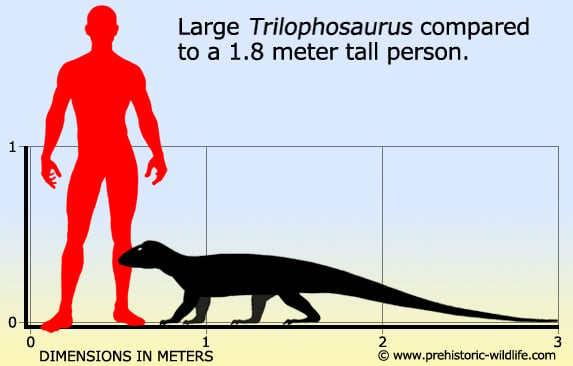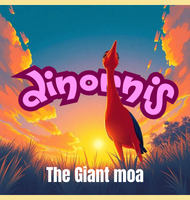In Depth
Trilophosaurus was quite a large genus of diapsid reptile that seems to have been like a particularly large Iguana in not only terms of general appearance but ecological niche. Trilophosaurus was a quadrupedal diapsid with a low slung body and a tail that made up over half of the total length.
The skull of Trilophosaurus is noted for being particularly solid, so much so that even the lateral temporal opening has disappeared. The skull is also high indicating it was more adapted for strength when biting. The cheek teeth are broad with strong shearing edges that could easily slice through plant material. Interestingly there are no teeth in the anterior (front) portion of the mouth, and the lack of teeth there has led to speculation that in life there would have been a horny keratinous beak for shearing plants prior to reaching the teeth. Altogether the suspected presence of a keratinous beak, strong cheek teeth and a particularly robust skull all point towards an animal that was processing tough vegetation when feeding.
The long toes and the curved claws on the ends of these would have been very good adaptations for climbing, though the large size of adult Trilophosaurus means that an arboreal life is hard to imagine for the genus. It could be that juvenile survival behaviour of Trilophosaurus was similar to what we see in monitor lizards today. When small and very light, juvenile monitor lizards spend most of their time in trees far from the reach of ground restricted predators. When they get older, larger and most importantly heavier however, they spend most of their time on the ground. If Trilophosaurus were the same, then juveniles would live in the trees safe from most predators, but by the time they were adults they would have been more restricted to the ground because of their size and weight.
When on the ground, adult Trilophosaurus would have had to keep an eye out for predators such as rauisuchians like Postosuchus which are known to have lived in the same locations at the same time as Trilophosaurus. The longs toes and claws however would have provided good grip on the ground however, meaning that Trilophosaurus may have feasibly been able to outrun the larger rauisuchians, especially if they saw them coming before they attacked.
First described in 1928, the taxonomic history of Trilophosaurus is already a little complicated. When first described, Trilophosaurus was thought to be a kind of cotylosaur, and at one time even a placodont, whereas today Trilophosaurus serves as the type genus for the Trilophosauria. The genus Chinleogomphius is synonymous with Trilophosaurus, while a species of Malerisaurus, M. langstoni is considered to be a synonym of the Trilophosaurus type species, T. buettneri (Spielmann et al, 2006). A third named species of Trilophosaurus, C. dornorum has also been speculated to be a synonym of the second species C. jacobsi (Spielmann et al, 2008).
Also, Trilophosaurus is often noted as being known from European remains, though when this article was being researched no collection numbers or locations for Trilophosaurus in Europe could be obtained. For this reason only the North American fossil bearing formations have been named above.
Further Reading
- A cotylosaur from the Upper Triassic of western Texas. Journal of Washington Academy of Science 18:177-178 - E. C. Case - 1928. - New reptiles from the Upper Triassic Chinle Formation of Arizona. - Journal of Paleontology 61(4):773-786 - P. A. Murray - 1987. - Late Triassic (Carnian and Norian) tetrapods from the southwestern United States. - New Mexico Museum of Natural History and Science Bulletin 4:1-254 - R. A. Long and P. A. Murry - 1995. – A new species of Trilophosaurus (Diapsida: Archosauromorpha) from the Sonsela Member (Chinle Formation) of Petrified Forest National Park, Arizona. - In W. G. Parker, S. R. Ash & R. B. Irmis (eds.), A Century of Research at Petrified Forest National Park, 1906-2006: Geology and Paleontology. Museum of Northern Arizona Bulletin 62:119-125 - B. D. Mueller and W. G. Parker - 2006. - Revision of the archosauromorph reptile Trilophosaurus, with a description of the first skull of Trilophosaurus jacobsi, from the Upper Triassic Chinle Group, West Texas, USA. - Palaeontology 49(3):621-640 - A. B. Heckert, S. G. Lucas, L. F. Rinehart, J. A. Spielmann, A. P. Hunt & R. Kahle - 2006. - Taxonomy and biostratigraphy of the Late Triassic archosauromorph Trilophosaurus. - New Mexico Museum of Natural History and Science Bulletin 40:231-240 - J. A. Spielmann, S. G. Lucas, A. B. Heckert, L. F. Rinehart & A. P. Hunt - 2007. - The Late Triassic archosauromorph Trilophosaurus. - New Mexico Museum of Natural History and Science Bulletin 43:1-177 [R. Butler/R. Butler] - J. A. Spielmann, S. G. Lucas, L. F. Rinehart and A. B. Heckert - 2008. – New trilophosaurid species demonstrates a decline in allokotosaur diversity across the Adamanian-Revueltian boundary in the Late Triassic of western North America – Palaeodiversity 13(1):25. – Ben T. Kligman, Adam D Marsh, Sterling Nesbitt, William G Parker & Michelle R. Stocker – 2020.










